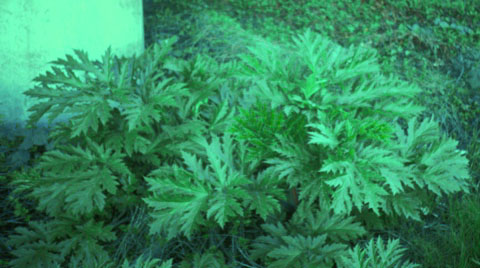
|
| Giant Hogweed; Heracleum Mantegazzianum Somm. & Lev. |
Carrot Family; UMBELLIFERÆ (APIACEÆ)
|
| A monocarpic herb of giant size, no larger weed is imaginable. This cousin of Angelica, Lovage and Parsnip is a native of
southwest Asia and the Caucasus. It was so monstrously impressive compared to its relatives that it was cultivated in European gardens by the
last decade of the 19th century. In rich, semi-shady English gardens the tallest reached 17 feet! It subsequently ran wild and became
hybridizing with the plant called Hogweed (because its leaves were fed to pigs) in England. So it came to be known as Giant Hogweed. Introduced
to North America, Giant Hogweed is now is wild in various places across the continent. |
| In the Seattle area it is usually known as Cow Parsnip. "Cow Parsnip" was an old English writer's name for Hogweed. Now a
North American perennial (Heracleum maximum Bartr., also known as
H. lanatum Michx.) is widely called by this name. This Cow Parsnip
is native in Washington, but is very rare in Seattle. Thus, to avoid confusion we should call our huge imported weed
Giant Hogweed or Giant Cow Parsnip. The native Cow Parsnip is comparatively small, rarely more than 6 feet tall. |
| A seedling Giant Hogweed, regardless of whether it sprouted in fall, winter or spring, generally requires three or four years
before it stores up enough energy in its roots to send up a flower stalk. A typical three-year-old plant will have huge leaves that die to the
ground in winter, then are succeeded by fresh new ones that arise from the root in late February or early March. These leaves grow up to
seven feet long, and have hollow, bristly, purple-blotched stems. Then the stout flower stalk begins building up, sending out a leaf or
two, branching near its summit into the flower heads. When the flowers open their snow-white petals from early June through mid-July, the
sight is one of tropical rankness. The central flower head can be over
11/2 feet across, like Queen Anne's Lace magnified five times. As the
seeds ripen, the giant cleft leaves turn yellow and wither; indeed the plant
dies as its seed ripens and scatters. |
| To grow one of these as a bold and eye-catching ornamental, the best place for it is in rich soil and partial sun. To get rid of it,
the policy is to simply let it flower, yet
not allow the ripening seeds to fully mature and scatter. To knock down the flower stalk, thinking
thereby to hurt the plant, is actually counter-productive. |
In any dealings with Giant Hogweed, wear gloves because its juice can cause severe skin blisters, especially in summer on sunny
days. It sensitizes the skin to ultraviolet light. Because of this dermatitic threat and its aggressive, spreading nature, it is covered in the
Federal Noxious Weed Act of 1974. Outlawed or not, it is here to stay. Maybe we should make the most of it by adopting an event recently
tried in Great Britain: hold a contest to see who can locate the largest specimen!
|
Originally published as the Seattle Tilth newsletter Weed of the Month in June 1988, along with an illustration drawn by Sylvan Haven.
Back |
|
|

